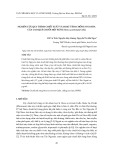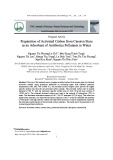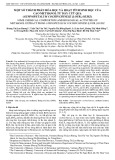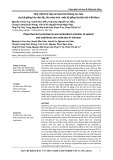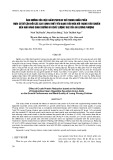
38 Nong Lam University, Ho Chi Minh City
The Journal of Agriculture and Development 23(6) www.jad.hcmuaf.edu.vn
this waste. SCGs contain large amounts of
organic compounds including lipid, cellulose,
hemicellulose, and lignin. Currently, SCGs have
been investigated for the production of biodiesel,
activated carbon, and a source of sugars (Preethu
et al., 2007; Mussatto et al., 2011; Caetano et al.,
2012){Mussatto, 2011 #1; Caetano, 2012 #20}.
Optimization of alkali-catalyzed organosolv treatment of spent coffee grounds
for obtaining polysaccharides
Duong T. T. Nguyen1, Sang V. Nguyen1, Dong N. T. Le2, Anh T. V. Nguyen1, & Ly T. P. Trinh1,2*
1Faculty of Biological Sciences, Nong Lam University, Ho Chi Minh City, Vietnam
2Research Institute for Biotechnology and Environment, Nong Lam University, Ho Chi Minh City, Vietnam
ARTICLE INFO ABSTRACT
Research Paper
Received: November 06, 2023
Revised: December 29, 2023
Accepted: January 08, 2024
Keywords
Alkali-catalyzed organosolv
treatment
Polysaccharide
Reducing sugars
Response surface design
Spent coffee grounds
*Corresponding author
Trinh Thi Phi Ly
Email:
phily@hcmuaf.edu.vn
The coffee industry is growing rapidly and generating increasing
amounts of spent coffee grounds annually. Spent coffee grounds
contain high levels of polysaccharide, which needs in-depth research
to obtain and transform into value-added products. This study was
carried out to optimize the alkali-catalyzed organosolv treatment
of spent coffee grounds to enrich the polysaccharide content. A
three-factor central composite design of the response surface
model was used to optimize the treatment variables including
reflux time, NaOH, and acetone concentration to yield the highest
polysaccharide level. As a result, the maximum polysaccharide
content was 73.13% obtained at a reflux time of 4.5 h, 62% acetone
with 0.91% NaOH. The polysaccharide-rich material from spent
coffee ground was composed of 39.37% mannan, 10.40% glucan,
and 9.33% galactan. Partial removal of lignin and protein was
observed during the treatment. Enzymatic hydrolysis of the spent
coffee polysaccharides released the highest reducing sugars of 5583
mg/L using an enzyme cocktail containing 4% of cellulase and 1%
of mannanase after 96 h. The enzymatic hydrolysate contained
3190 mg/L mannose and 1790 mg/L glucose, showing a feasible
transformation of spent coffee polysaccharides.
Cited as: Nguyen, D. T. T, Nguyen, S. V., Le, D. N. T., Nguyen, A. T. V., & Trinh, L. T. P. (2024).
Optimization of alkali-catalyzed organosolv treatment of spent coffee grounds for obtaining
polysaccharides. The Journal of Agriculture and Development 23(6), 38-49.
1. Introduction
Spent coffee grounds (SCGs) have no
commercial value and are usually discarded as
solid waste or sent to compost facilities. In recent
years, the increasing need for waste reduction
and environmental protection has stimulated
the search for possible methods of valorizing

Nong Lam University, Ho Chi Minh City 39
The Journal of Agriculture and Development 23(6) www.jad.hcmuaf.edu.vn
Being a porous and carbon-rich material, SCGs
have been studied to become an inexpensive
heavy metal adsorbent to replace traditional
materials (Fiol et al., 2008).
Polysaccharides account for about
50% of total SCGs (Trinh et al., 2022).
Arabinogalactan, galactomannan and cellulose
are major polysaccharides in the SCGs, in which
galactomannan is the most abundant component.
Galactomannan has been noted as an excellent
stiffener and stabilizer of emulsions, which
shows potential in the food, pharmaceutical,
and cosmetic industries (Ballesteros et al., 2015).
Some findings have shown the antimicrobial
and antioxidant capacities of polysaccharides
extracted from SCGs (Ballesteros et al., 2015)
and the immunostimulatory properties provided
by coffee galactomannans and arabinogalactans
(Simões et al., 2009). The prebiotic potential
of spent coffee mannan has been also proved
since it improves the health of humanintestinal
microflora (Asano et al., 2003; Gniechwitz et
al., 2007). Besides being applied in the food and
biomedical sector, spent coffee polysaccharides
have been performed with potential uses in the
manufacture of biodegradable materials.
The application of spent coffee
polysaccharides is limited due to the presence
of other components such as lignin, phenolic
compounds, protein, and lipids attached to its
structure. In our previous study, SCGs were
treated using alkali and solvent to remove
these components and make changes in SCG’s
structure. As a result of this, we obtained
polysaccharide-rich materials that were
effectively hydrolyzed into soluble sugars (Trinh
et al., 2022). Combining alkali and solvent
significantly improved the delignification
of SCGs because both agents can cleave the
ester linkages between polysaccharides and
lignin. From these important findings, the
present study was conducted to optimize
the alkali-catalyzed organosolv treatment of
SCGs to achieve the highest polysaccharide
level. Polysaccharides derived from SCGs can
be applied in various sectors such as foods,
medicals, and biomaterials. The conversion
of SCGs into value-added products not only
provides benefits for the coffee industry,
improves income for farmers, but also reduces
environmental impacts.
2. Materials and Methods
2.1. Materials
The SCGs were obtained from branched coffee
shops in Ho Chi Minh City from October 2022
to December 2022. The collected samples were
mixed and dried at 50°C until their moisture
content reached below 10% before storing at
room temperature.
Cellulase enzymes (700 EGU/g) and
Mannanase enzymes (500 U/g) were provided
by Novozyme and LeafCleanTech, respectively.
3,5-Dinitrosalicylic acid (DNS) was purchased
from Duksan (Korea). Citric acid monohydrate
and sodium sulfite were purchased from Merck.
Sodium citrate trihydrate, Rochelle salt, sodium
hydroxide, phenol, and n-hexane were supplied
by Xilong (China).
2.2. Methods
2.2.1. Defatting
The SCGs were defatted using the process
described previously with some modifications
(Trinh et al., 2022). Briefly, 100 g of SCGs were
immersed in n-hexan overnight with a ratio of
material to solvent of 1:5 (w/v). The lipid extraction
was conducted by sonication for 30 min twice.
The defatted SCGs were separated by filtration
and dried in an oven at 60oC. Its moisture content
was measured before further experiments.

40 Nong Lam University, Ho Chi Minh City
The Journal of Agriculture and Development 23(6) www.jad.hcmuaf.edu.vn
design (CCD) of response surface methodology
(RSM). Three independent variables were reflux
time (X1, 0.5 - 6.5 h), NaOH concentration (X2,
0.1 - 1.3%), and acetone concentration (X3,
10 - 90%). There were 21 experimental runs
including eight factorial points, six axial points,
and seven center points. The significance level
of the response surface model and the equation
terms were studied by analysis of variance
(ANOVA) with 95% confidence on Minitab
16 software. The quality of fit of the regression
model was evaluated through the coefficient
of determination (R2), adjusted correlation
coefficient (adj-R2), and predictive correlation
coefficient (pred-R2. Independent variables and
their levels used in the response surface design
are presented in Table 1.
2.2.2. Alkali-catalyzed organosolv treatment
of spent coffee grounds
Polysaccharide-rich materials were obtained
by removing lipid, lignin, protein, and some
phenolic compounds in the SCGs matrix.
Defatted SCGs were treated by refluxing (0.5 - 6.5
h) using aqueous acetone (10 - 90%) with a ratio
of material to solvent of 1:10. Alkali (NaOH)
functioned as a catalyst with a concentration
range of 0.1 - 1.3% (w/v). After processing, the
solid was washed intensively with distilled water
to remove residual alkali and other degradation
products until the pH value reached 7.0. The
solid was dried at 70oC and stored at 4oC before
determining the polysaccharide content.
2.2.3. Experimental design
Optimization of polysaccharide content in
SCGs was conducted using a central composite
Table 1. Independent variables and their levels used in the response surface design
Independent variables Unit Coded Coded factor level
- α -1 0 +1 + α
Reflux time h X10.5 2 3.5 5 6.5
NaOH concentration % X20.1 0.4 0.7 1 1.3
Acetone concentration % X310 30 50 70 90
2.2.4. Determination of polysaccharide content
Polysaccharide content in the treated SCGs
was determined by measuring the total reducing
sugars released during the complete hydrolysis
process using sulfuric acid reported previously.
Polysaccharide-rich materials were hydrolyzed
with 72% aqueous sulfuric acid for 60 min at
30oC, then distilled water was added to the
mixture to dilute the acid to a 4% concentration,
which was autoclaved for 60 min at 121oC. The
acid hydrolysate was made up to a volume of 100
mL. Total reducing sugar content was quantified
using 3,5-dinitrosalicylic acid (DNS) assay
(Miller, 1959). Briefly, 1 mL of sample or glucose
standard was mixed with 1 mL of DNS reagent.
The mixture was kept in a boiling water bath
for 5 min, then cooled down by immersing in a
cold water bath before adding 3 mL of water. The
absorbance of the mixture was measured using a
spectrophotometer at 515 nm. Glucose was used
as the standard with the range of 50 - 300 mg/L
(Trinh et al., 2022).

Nong Lam University, Ho Chi Minh City 41
The Journal of Agriculture and Development 23(6) www.jad.hcmuaf.edu.vn
in a shaker at 120 rpm. The hydrolysate was
collected every 24 h and then filtered through a
nylon membrane of 0.22 μm before determining
the total reducing sugars and monosaccharides
(Trinh et al., 2022).
2.2.7. Analysis of monosaccharides
Monosaccharides including mannose,
glucose, and galactose in the acid and enzymatic
hydrolysate were determined by high-
performance liquid chromatography (HPLC
Agilent 1200 Infinity II) (Sluiter et al., 2008).
The Rezex RPM-Monosaccharide Pb+2 (8%)
column (100 x 7.8 mm) was stabilized at 40oC.
The refractive index (RI) detector was set up at
80oC. The mobile phase was deionized water
with a flow rate of 0.2 mL/min. Monosaccharide
standards were prepared in the range of 100 -
1000 mg/L (Trinh et al., 2022).
3. Results and discussion
3.1. Optimization of treatment conditions of
SCGs for obtaining polysaccharides
The experimental matrix, actual values,
and predicted values are shown in Table 2. In
the optimized model, the significance level P <
0.05 was used to test the effect of independent
variables and their interaction with the response
variable. The effect of reflux time (X1), NaOH
concentration (X2), and acetone concentration
(X3) on polysaccharide content (Y) was expressed
by a regression equation as follows:
2.2.5. Chemical compositions of spent coffee
grounds
The moisture content of SCGs was measured
by gravimetric analysis after drying in an oven at
105oC until obtaining constant weight mass. The
nitrogen content of SCGs was estimated by the
Kjeldahl method according to TCVN 10791:2015
(VS, 2015) and the protein content was measured
using an appropriate Nitrogen Factor of 6.25.
Ash is the inorganic residue remaining after dry
oxidation at 550°C. The ash content of SCGs was
quantified by gravimetric analysis according to
TCVN 8124:2009/ISO 2171:2007 (VS, 2009).
Acid-insoluble lignin or Klason lignin is the
residual fraction after removing the ash by the
complete acid hydrolysis of SCGs (Sluiter et al.,
2008). Acid insoluble lignin was estimated by
gravimetric analysis of the dry solid residue on
the crucibles subtracted from the ash.
2.2.6. Enzymatic hydrolysis of SCGs
Polysaccharides obtained from SCGs
can be used as a source of sugars through
enzymatic hydrolysis. The treated SCGs were
hydrolyzed using a combination of commercial
polysaccharide-degrading enzymes including
cellulase (Cellulast, 0 - 5%, enzyme to substrate)
and mannanase (0 - 5%) at different ratios. The
control experiment was conducted without
adding an enzyme. Enzymatic hydrolysis
experiments were performed in 0.05 M citrate
buffer at pH 4.8 with a ratio of material to buffer
of 1:25 (w/v). The mixture was incubated at 50°C
Polysaccharides (%) = 44.94 +1.19X1 +62.70X2 –0.058X3 –1.731X1
2 –63.66X2
2
–0.010327X3
2
><
3.82X1
><
X2 +0.1782X1 x X3+0.5809X2
><
X3

42 Nong Lam University, Ho Chi Minh City
The Journal of Agriculture and Development 23(6) www.jad.hcmuaf.edu.vn
determination coefficient of 0.9437 (pred-R2)
was high indicating the reliability of predicted
values. In addition, the predicted-R2 was in
reasonable agreement with the adjusted-R2 (the
difference < 0.2). Furthermore, the p-value of
lack of fit was not statistically significant (P >
0.05) demonstrating the regression model was
compatible with the actual experiments.
Table 2. Response surface central composite design for polysaccharides
Treatment conditions Polysaccharide content
Run Time (h) NaOH concentration
(%)
Acetone concentration
(%)
Actual
value (%)
Predicted
value (%)
1 2.0 0.4 30 63.73 64.96
2 5.0 0.4 30 53.75 52.80
3 2.0 1.0 30 66.06 64.15
4 5.0 1.0 30 58.19 58.86
5 2.0 0.4 70 46.07 44.88
6 5.0 0.4 70 52.73 54.10
7 2.0 1.0 70 57.59 58.01
8 5.0 1.0 70 75.84 74.10
9 0.5 0.7 50 54.72 55.19
10 6.5 0.7 50 59.06 59.12
11 3.5 0.1 50 40.70 40.22
12 3.5 1.3 50 58.41 59.42
13 3.5 0.7 10 58.41 58.63
14 3.5 0.7 90 53.49 53.79
15 3.5 0.7 50 72.81 72.74
16 3.5 0.7 50 71.55 72.74
17 3.5 0.7 50 72.50 72.74
18 3.5 0.7 50 73.98 72.74
19 3.5 0.7 50 72.54 72.74
20 3.5 0.7 50 72.54 72.74
21 3.5 0.7 50 72.54 72.74
Table 3 shows an analysis of variance
(ANOVA) for the response surface quadratic
model. The regression model was statistically
significant (P < 0.05) and the reflux time, NaOH
concentration, and acetone concentration
significantly affected the polysaccharide content.
The coefficient of determination R2 = 0.9909
demonstrated experimental data were fitted well
to the predicted model. The value of the predicted




